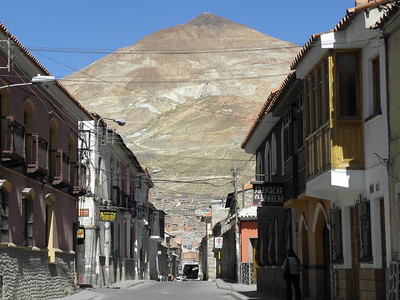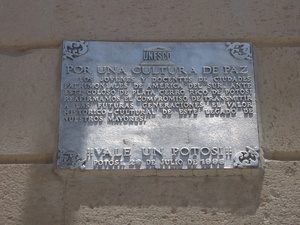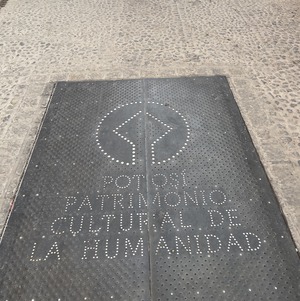Potosi

The City of Potosí comprises an urban and industrial landscape shaped by one of the major silver mines of modern times.
Dating from the 16th century and still in use, the site shows the whole production chain (including dams, smelters and ore-grinding mills) and its social context in the colonial city center. Its architecture and arts, using a baroque style incorporating Indian influences, have been influential across the Central Andes. It delivered so much silver to Spain that it resulted in major economic change.
Community Perspective: La Casa de la Moneda (the former Mint) is now the main attraction in the city. Our reviewers have mixed opinions on taking an underground tour of Cerro Rico mine, arguments pro are given by Michael Anak Kenyalang and some of those against by Timonator. Potosí can best be visited as a day trip from Sucre, as the combination of dust, dirt and altitude make it a not very pleasant place to stay.
Map of Potosi
Community Reviews
J_neveryes

It was already dark as my bus from Tupiza entered Potosi's bus terminal, a busy place where ticket sellers' loud sales announcements reverberated around the circular hall like monks' chants. The scene outside the bus terminal was even less impressive with busy traffic and vernacular buildings. First impressions of Potosi were not great.
Once the taxi entered the historic part of the city, however, the mood - both mine and the city's - changed. I remember how seeing the columns of Plaza 6 de Agosto being illuminated by lights made me feel happy. Going for a walk in the night, I found areas that were peacefully calm but also areas that were lively with people going out for drinks (or bubble tea) or had a musical parade going through it.
During the day, I discovered a hardworking city with Andean Baroque architecture and overhanging covered balconies. Potosi's engaging colonial buildings and preserved history makes it more worthy as a two or more days destination rather than a day trip stop.
With respect to the mine tour of Cerro Rico, I did go on it. In the tour was just me and a Belgian tourist. The other tourist - a man probably in his late 20s - had a lot of difficulty breathing and keeping up and decided to quit the tour about a 1/3 way into it, which meant that I was left alone in the dark mine while the guide accompanied the other tourist out (I decided to continue the tour because, well, you know, you always want to do better than a Belgian). When the guide returned, we entered tunnels that were very small and required me to crawl at times, sometimes down slope. There was also an unstable looking ladder at one point that gave me pause.
I found myself breathing hard during the tour, and I first wasn't sure if it was panic-induced or the lack of oxygen. I now do think it was more likely the lack of oxygen.
Setting aside the potential physical discomfort of it, should you go on the tour, politically or ethically speaking? I think that depends on how you approach it. If you want to go on the mine tour for an adrenaline rush or an adventure, then I think you should reconsider. This is a working mine, and people have died in the mines or due to illnesses arising from mining. Respect should be given.
On the other hand, I do think you can go on this tour to learn without feeling morally dirty. It is helpful, for example, that there isn't much opportunity to gawk at the workers. Near the mine entrance, we did encounter a couple of miners (and we dropped off gifts for them in their carts), but we mostly toured tunnels that were not being actively mined. This reduced the chance of us getting in the way of people working or for the tourists to either intentionally or unintentionally treat the workers as if they were creatures in a zoo or people to be pitied.
What is important, I think, is for people who visit the mines to then think about why these workers work in such dangerous conditions. For hundreds of years miners and forced labourers toiled and died to make the few obscenely rich. Now that the mountains have given up most of its wealth, the scraps have been left for the desperate to make some income for themselves. There are many mines today in South America - many operated by mining companies from my home country, Canada - that continue to exploit the environment, the communities, and the workers. Cerro Rico is not just a history lesson, but a view into what is happening currently.
Timonator

During my four and a half days in Potosí I used only 2 days to actually visit the city. 2 days I was waiting with my girlfriend that her headaches would go away. She was blaming the cold and dry air during the nights at 0°C, I suspected rather the altitude of 4000 m that Potosí has. Anyhow the two non- consecutive days passed by and during the other two days we were able to visit the mint, the St. Theresa monastery, do a touristic bus tour through the city, visit some other churches from the outside or sneak peak into the service and watch a first league football match of Nacional Potosí on a really high level ;).
The last half day I waited in the hostel for my girlfriend who participated in a tour visiting the mines of Cerro Rico which I decided against even though parts of them logically belong to the story of the WHS. Working in a Western European Utility for whole of my working life I didn't dare to visit a workplace of others that surely would be shut down or run completely differently in the hands of my former employer in terms of respect to the workers and their safety. She found the visit interesting however had a really bad guide and knows more about the mines from reading now than from her actual visit which surely shows a tough environment however doesn't obviously display all the malconditions of the working place environment.
Most important in Potosí I find to visit the mint which is nowadays a good museum and for hundreds of years was the place where the money was produced- first 300 years for Spain and then another hundred years for Bolivia. Nowadays the Boliviano is produced in Chile, France and Canada and the silver, plum, zink & Co are fetched from the Cerro for other purposes. The guided tour even though private and in English was of medium quality as the English of the guide was hardly understandable and English questions were answered however the answer had not a lot to do with the question. In Spanish however communication was possible and the main story was understandable by explainations plus displays and is really interesting.
According to the UNESCO description the rest of the WHS consists of Church San Lorenzo, (probably I have seen it from the outside but both Google and locals couldn't confirm), the old workers barrios (tourist info couldn't really help with where that is), colonial builduings, which are everywhere especially around the central plaza 10 de noviembre, and old industrial heritages of which we visited one Ingenia where the raw silver was worked on with hydropower before it went to the mint (the touristy bus starting weekdays at 09:00 and 14:30 at the plaza goes here) and the lagunas Kari Kari to which we wanted to hike however due to lacking health and the fact that others told us it's not possible to visit the place as recently a drunk person (almost?) drowned in the water and now locals prevent people to visit, we decided not to go.
Beyond the WHS sites the guided tour in the monastery St. Theresa for nons was interesting however could have been much more exciting if our guide didn't present every room like a robot in Spanish and if we were not thrown into a running tour in the middle of its visit.
All in all Potosí has some interesting and beautiful places to visit but the combination of all the dust from cars and dirt and the height makes it a not very pleasant place to stay. I was kind of happy leaving Potosí again in the hope of a better stay in Sucre, which is not a usual sign for me when I enjoyed a place a lot.
Read more from Timonator here.
Nan

Getting to Potosi had been a dream of mine ever after having visited some of the silver mines of Mexico. Potosi was the largest silver mine of the Spanish empire and its crown jewel. To this day "Vale un Potosi" is a standing expression in Spanish for "worth a fortune".
The Potosi mine was a gruesome place. The high altitude of the mine at 4000m made the already terrible working conditions of a 16th century mine even worse. Similar to other parts of the Americas they tried using African slaves, but they tended to die off too quickly in the high altitude. So the work was mostly done by the local native Americans.
To this day the Potosi mines are a pretty dangerous places for miners. And for visitors. So you should consider if you want to join a tour. I decided against it and spent my time visiting the old town. The most notable structure in town is the royal mint, the casa de la moneda. I would recommend joining a tour to get a feeling for the site and the silver processing.
Personally, I enjoyed the Mexican silver towns better. Potosi is a historically important site and deserves inscription. It just isn't the nicest example of the type of town. And it lacks the quirkiness of my personal highlight, Guanjuato.
Getting There
I came by bus from Uyuni having also ticked off Pulancayo (T). If you are in the area a visit to the Salar de Uyuni is a must. I left by shared cab to Sucre.
Michael anak Kenyalang
You have to join a tour to get into the mines of Cerro Rico. When I got to the assembly point I was told that the other tourists that were supposed to join the group didn't show up (heard that they were drunk, LOL) so it left only me in the tour. Even it's only me but the tour still kept on, so I was like a VIP. We got into a small van and went to a place to suit up. We were provided with a helmet with a torchlight, hand gloves, boots, a thin jacket and pants. Then we went to the miners' market. As the 3rd generation miner and an ex-miner, my guide Antonio explained well to me about the history of Cerro Rico and the real miner story of himself on the way to the market.
When we arrived at the miners' market, we bought some water and coca leaf for the miners. Since it's one on one, Antonio told me a lot of extra things about the usage of coca leaf for the miners, like how they could work whole day with just eating coca leaf and how to heal themselves with coca leaf.
We went to see the city of Potosi and Cerro Rico as background at the mirador (lookout point) Then the journey into the mine tunnel started. Since I was the only one, Antonio brought me to his former working place Minas de San Miguel. It's a bit different from the touristic mines as this is still a functioning mine and it requested a bit of climbing up and down. Strongly suggest taking a mask with you as it's a bit dusty down there when the workers operated. We went to 4 different levels and got to meet 3 workers. It's quite shocking getting to know that they worked day and night without much rest. Antonio brought me to the so called "museo" to see some figures of Spaniard and African worker. At the same place also got the biggest "El Tio" in Cerro Rico. Antonio also shown me different types of minerals harvested in the mine.
The journey took around 3 hours. It's really a special experience to see how a mine works from the Spaniard era till present day. And especially from the mouth of an ex-miner telling the difficulties they are facing at the moment. If you want to experience something different, this is it.
Els Slots

The approach to Potosí is magnificent - the road from Sucre already is a fine drive of 2.5 hours mostly on the Altiplano, but the first sight of the Cerro Rico (where all Potosi's riches came from) is truly exciting. There have been reports over the last few years that it is in danger of collapsing totally because of over-mining, but it still seemed to be a very sturdy mountain to me. It completely dominates the compact city beneath it.
As in Sucre, opening hours to the sights of Potosi are fairly limited and unreliable. I had left Sucre early to be able to visit at least its main attraction - La Casa de la Moneda. This former Mint is now set up as a museum, displaying both parts of its former use and miscellaneous exhibitions on art, archeology, and geology. One of its prize pieces is the 18th century La Virgen del Cerro, a work of the Potosi school depicting the whole (partly mythical) story of the Cerro Rico.
I had decided against visiting the interior of one of the mines early on - too claustrophobic for me. So I just wandered about in the fine colonial city center, sat on its main square, visited the bright Santa Teresa Monastery, and even meandered into the outskirts of the city to have a look at one of the former smelters, the Ingenio San Marcos.
Knowing the city's history, it's an impressive place to visit. Though as with all other sites in Bolivia that I have visited so far, it lacks the really outstanding surprises that turn a WHS visit from "good" into "great".
Veronica
As a Bolivian I am so proud that Potosi has been declared a World Heritage site. At the height of its splendor it is said to have rivaled London, Paris and Madrid in it's population size. It is also written that for some religious procesion the streets where paved with silver ingots that just poured out of "Cerro Rico" and which later where exported to Spain.
Many of us have forgotten or do not know about the past glory this little city high in the Andes has brought our country. It is truly a world heritage site. It would be wonderful to be able to access more infomation on it, to be able to see the art and read more of the stories about the ostentation the families of the miners lived. Almost like the bubble lived here in the US by the IPO generation :)
Community Rating
- : Zoë Sheng Maxine Eisenberg Ssong.x
- : Pablo Tierno Philipp Leu Lameduck99 Rvieira
- : Stanislaw Warwas Michael anak Kenyalang Argo Christravelblog Drazsika Francky D'Hoop Cmtcosta Adrian Turtschi Alejandro Lau
- : Els Slots Michael Ayers Walter Xiquinho Silva Rickard Alfredsson Kevin247 Carlos Sotelo JoStof Pchxiao J_neveryes Boppare
- : Nan Alexander Parsons Shandos Cleaver Krijn Tevity Lucio Gorla Ammon Watkins Londonium Timonator Richard Stone
- : Lukasz Palczewski Thomas van der Walt
- : Palimpsesto
- : Bram de Bruin
- : Natlefebvre@hotmail.
Site Info
Site History
2014 In Danger
uncontrolled mining operations, instability and risk of collapse of the Cerro Rico
1987 Inscribed
Site Links
Unesco Website
Official Website
In the News
Connections
The site has 25 connections
Constructions
Ecology
Geography
Human Activity
Individual People
Literature and Film
Religion and Belief
Science and Technology
Timeline
Trivia
WHS on Other Lists
World Heritage Process
Visitors
144 Community Members have visited.
The Plaque
 (photo by Jarek)
(photo by Jarek) (photo by Bram de Bruin)
(photo by Bram de Bruin)